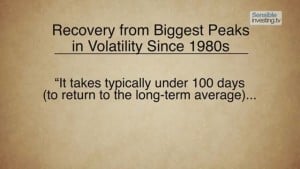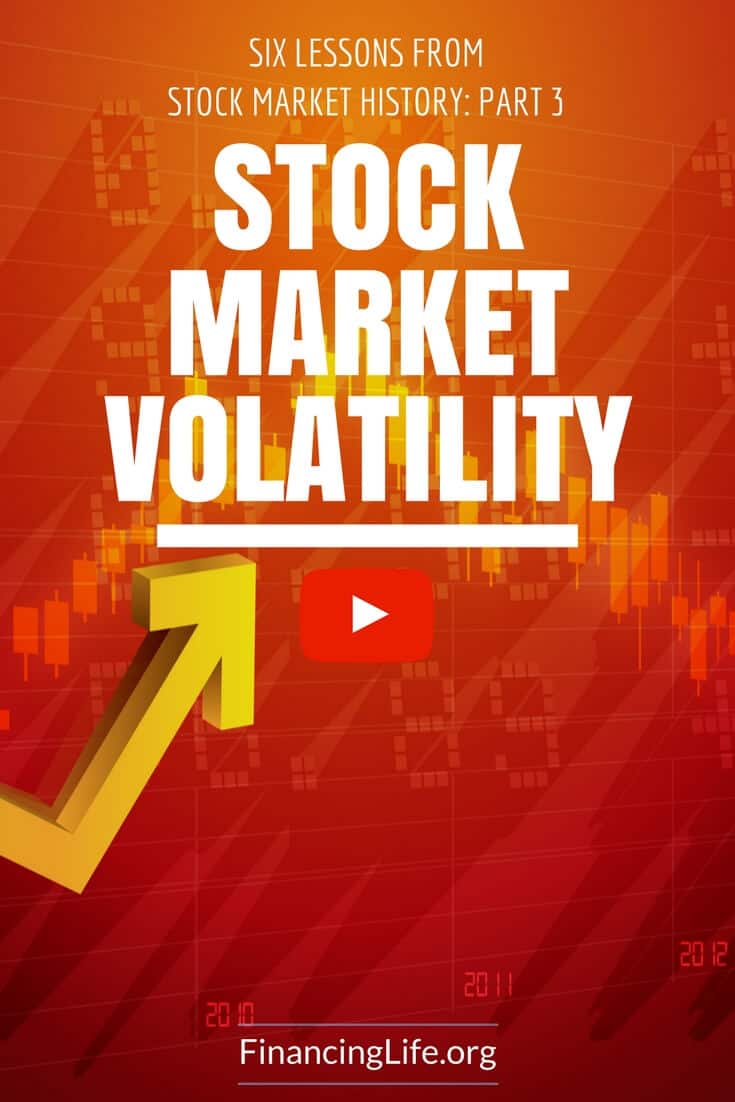This 8-part series about investing in stocks is for beginners who want to learn how to invest. This lesson looks at the long history of market volatility. This outstanding video series was produced by SensibleInvesting.tv. I have created a summary and transcript to help you find spots that interest you and make the best use of your time.
Summary of video: Lessons From Stock Market History Pt.3: market volatility
NEXT STEPS: Watch the 8-part series Lessons from Stock Market History
- Part 1: world stock markets (video)
- Part 2: market expectations (video)
- Part 3: market volatility (video)
- Part 4: stock market timing (video)
- Part 5: keep investing simple (video)
- Part 6: diversify stocks (video)
- Part 7: buy and hold (video)
- Part 8: sensible investing (video)
SensibleInvesting.tv is an independent voice that makes important educational videos about passive investing—the best I’ve seen. This series features some of the biggest names and brightest minds in the investment world. It is presented and produced by Robin Powell and his team at SensibleInvesting.tv, and published on YouTube. It is a great honor to include it in our collection of video tutorials about “Investing in Stocks”.
Key points about investing in stocks from this video:
- The second lesson to learn from market history is to stay calm.
- All investing involves a degree of risk, and market volatility is inevitable.
- There’s a direct mathematical link between risk and expected returns.
- The most efficient strategy is to hold a broadly diversified portfolio.
- The problem is that in bad times investors are often emotional.
- Markets do recover, and often far more quickly than expected.
Transcript of: Lessons From Stock Market History Pt.1: world stock markets
(At 0:07 start Robin Powell, reporter)
If parts one and two of this video series with their focus on bubbles and crashes have put you off investing, then part three is designed to address the balance. That’s because the next key lesson to learn from market history is to stay calm. All investing involves a degree of risk, and market volatility is inevitable. It goes with the territory, but more than that there’s a direct link between risk and expected return. That by the way is not a theory but a mathematical fact as confirmed in the Capital Asset Pricing Model, which earned its authors the Nobel Prize in Economics.
(0:48 Prof. William Sharpe, Nobel Prize-winning economist)
There are really sort of two key takeaways if you will. One is the most efficient strategy for an investor is to hold a broadly diversified portfolio reflecting the market of securities that are available. The second is that there will be a reward in higher expected return for bearing risk, but the kind of risk for which the reward should be available is the risk of doing badly in bad times.
(1:17 Robin)
The problem is of course that in those bad times investors are often emotional. When prices fall sharply and further falls are predicted, we tend to panic to reduce our exposure, or bail out all together. But history shows that’s just the wrong thing to do because almost invariably prices eventually recover.
(1:37 Richard Wood, Barnett Ravencroft Wealth Management)
Going back to the end of 2007, the publicity and the news was all very, very doom and gloom. We had a potential collapse of some pretty significant countries, in particular Greece, then we had Cyprus. They were talking about the failure of Spain, Ireland, and we had to prop up the currencies, we had to prop up the banks. In fact, I remember there was a certain journalist and documental commentary on the TV that was saying that this is the next Great Depression and it’s going to like the 1930s for the next ten years.
(2:06 Robin)
It’s because it was the most recent crash that 2008 is the one we tend to focus on today, but all through market history there have been events which seem catastrophic at the time, but in hindsight appear a blip. Take the famous bubble of 1720 for example, when the South Sea Company collapsed like a house of cards.
(2:26 Dr. David Chambers, University of Cambridge)
If you had stayed in you would have, a few years later in 1723, you would have received compensation for your shares and in fact as a result of that even though investors felt a little bit sore in London for having experienced some losses, they stayed faithful with the stock market as a concept, and the infrastructure of stock trading in London as well as the appetite for investors for investment risk largely remained in-tact.
(2:58 Robin)
In fact, not only do markets recover, they often do so far more quickly than expected.
(3:04 Prof. Elroy Dimson, London Business School)

After we’ve hit an absolute peak in volatility, how long does it take for volatility to go all the way back to its long-term mean? The answer is if we look back at the eleven biggest peaks in volatility since the 1980s, it takes typically under a hundred days. To get halfway back, it has on average taken only eleven days. If you were thinking of adjusting your investment strategy to respond to a peak in market volatility, by the time you’ve actually got around to doing anything it’s too late anyway.
(3:42 Prof. Janette Rutterford, Open Business School)
The 1974 crash, the market fell and I can remember people saying this is the end of the stock market. The stock market will actually go down to zero and pension funds were just desperately selling equities at the end of 1974, and yet 1975 saw the biggest rise I think in any month that anybody had ever seen.
(3:59 Weston Wellington, Dimensional Fund Advisors)
Every investor’s experience is a product of two factors. It’s the capital market return that is being offered by the securities market around the world, but then it’s shaped by your response to those capital market returns, your own behavior. We see too many sad stories of people who had every opportunity presented to them by the capital markets to have a very rewarding investment experience, and they’ve made a hash of it by dashing into the markets after they’ve gone up and bailing out of the markets after they’ve gone down.
(4:33 Robin)
You might be thinking, “Okay, I get it. I should ride out any volatility because markets always recover, but wouldn’t it be great if I could just get into the market as a bull run begins as one did in 1990, and get out again when it ends in a new bear market begins in 2000?” Well, hold that thought right there and join us again for part four.
Footnotes and Credits:
This video was produced by SensibleInvesting.tv and published on YouTube July 25, 2013 on their YouTube channel SensibleInvesting. Their videos are the best I’ve seen on this topic. They produce them and own the copyright. They have given me permission to embed this via YouTube license onto this educational website.
Sensibleinvesting.tv provides information and opinion on low-cost, evidence-based (passive) investing. They are based in the United Kingdom, but their lessons are universal.
********* Please Share **********
If you like this video, please share this pin and follow me on Pinterest. It’s an easy way for you to help others to find this educational resource.

